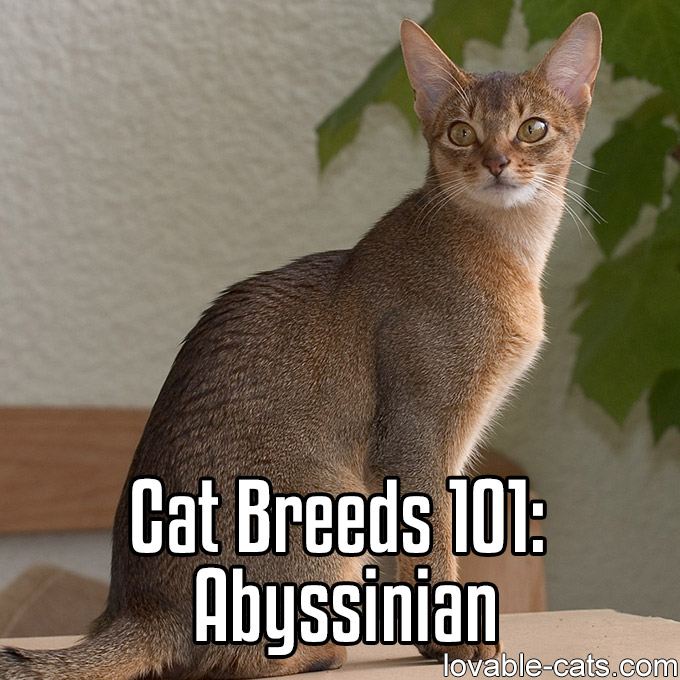
Cat Breeds 101: Abyssinian – Image To Repin / Share
Photo: Wikipedia – lic. under CC 3.0
The Abyssinian cat breed was once thought to originate from the old African country of Abyssinia (now called Ethiopia), hence its name. Recent research, however, says that this breed actually originated from Egypt [1] or Southeast Asia. [2] (It even appears in Ancient Egyptian sculptures and murals.) Some also say that the original breed was decimated in the Western world during the Second World War and was only recreated by breeders later on. [1]
Although the exact roots of the Abyssinian are still somewhat unclear, one thing is for sure: the breed did not originate from Ethiopia, even though that’s where its first British owners got it from.
Today, this slender, shorthaired, tabby-coated cat is one of the five most popular cat breeds in the United States. [2] That comes as no surprise, because the Abyssinian is friendly, playful, and full of pep. It’s also quite intelligent – it is believed to be one of the smartest cat breeds known to man.
Its IQ, however, is not the Abyssinian’s defining characteristic. Rather, it is its tabby-ticked coat. Happily, ‘ticked’ in this case does not indicate a small-arthropod infestation. Instead, it describes a hair pattern where each individual strand has bands of color that go from a lighter-colored root to a darker-shaded tip.
The recognized Abyssinian color patterns include ruddy tips with a reddish-brown base, chocolate brown with a cinnamon base, blue with a beige base, fawn with a cream base, and black with a silver base. Other characteristics of this breed include a wedge-shaped head, large and pointy ears, a long and graceful tail and legs, and dainty paws. The Abyssinian’s eyes can be gold, hazel, or green. They are always almond shaped and strikingly expressive. [3]
The Abyssinian’s energetic temperament can make it a fun family pet. But be warned – sometimes this cat breed can be a little too much fun. Its voice may be quiet, but that’s only so you aren’t warned early of the mischief it’s brewing. It may be a good idea to fill your house with toys to amuse your Abyssinian, but that won’t necessarily keep it from unrolling your toilet paper or swinging from your chandelier. This breed could be a good option if you’re looking for something to keep your kids sufficiently occupied, especially if your kids are old enough to roll the tissue back onto the tube and clean up other traces of your Abyssinian’s fun. [1]
If well cared for, your pet Abyssinian will keep your life exciting for a good number of years, as it has a lifespan of up to 15 years. There are not a lot of health issues that this breed is subject to. The best-known hereditary disease afflicting the Abyssinian is pyruvate kinase deficiency (PK), which can manifest at any time in your cat’s life. But a more common Abyssinian cat disease is gingivitis.
Unfortunately, there is no known “best treatment” for PK, which manifests itself as periodic anemia. Gingivitis, however, can be prevented simply by giving your Abyssinian a weekly tooth brushing, as well as by bringing it in for professional tooth cleaning every year with your friendly neighborhood vet. [4]
References:
[1] Abyssinian Cat. Petfinder. https://www.petfinder.com/cat-breeds/Abyssinian
[2] Abyssinian. Vetstreet. https://www.vetstreet.com/cats/abyssinian
[3] Abyssinian cat. https://en.wikipedia.org/wiki/Abyssinian_cat
[4] https://petcyclopedia.com/cat/56/abyssinian/
